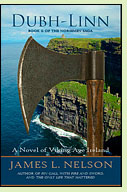Dubh-Linn
by James L. Nelson
Reviewed by David Maclaine

With Dubh-Linn: A Novel of Viking Age Ireland, Nelson returns to the characters and, crucially, the setting of Fin Gall, his previous novel. My gratitude that someone is mining this rich arena for fiction is such that I’m willing to forgive a few missteps. In this sequel, the brooding Norse warrior Thorgrim Night Wolf wants to return to his farm across the North Sea, but is instead drawn once more into conflicts that include warring Irish factions and the thriving Scandinavian settlement we now call Dublin. Two Irish women who figured prominently in Fin Gall, Morrigan and Bridget, are competing to rule Tara, the ancient center of Irish rule and key to the kingdom of Brega, an important neighbor of the Viking colony of Dubh-Linn. One of them is bearing Thorgrim’s grandchild, so it will come as no surprise that his family are among the Norsemen drawn into a multi-sided battle of shifting alliances.
Perhaps the strongest part of Dubh-Linn is its picture of the town, especially the portrayal of the local Irish learning to live profitable lives in the island’s first real urban center. The plentiful action sequences are as energetic as ever, including a daring assault on a walled village, an attack on a household that leads to a running street fight, and a final battle for Tara itself. Figuring prominently in these fights is a new character, the beserker Starri Deathless, who has a knack for surviving against hopeless odds. Nelson’s handling of the Irish side of the story is sometimes shaky: he again oversimplifies Irish politics and misrepresents the manner of succession to kingship, and his Irish warriors are far better equipped and organized than the sources suggest. But giving readers of fiction even a small, blurred window into this great phase of human history is an accomplishment worth celebrating. (2014, 330 pages)
More about Dubh-Linn at Amazon.comOther novels about Vikings in Ireland:
Fin Gall by James L. Nelson (2012), about a ninth-century Viking crew who plunder an Irish ship and find themselves battling not only the Irish but also the Danes in control of Dublin. See review or more info at Amazon.com
The Deepest Sea by Charles Barnitz (1996), historical fantasy about the sea voyages of the son of a Viking settler in Dublin, Ireland, in the late eighth century. See review or more info at Amazon.com
Vinland by George Mackay Brown (2005), about a young Viking who voyages from Orkney to Norway, Iceland and Ireland during the shift from paganism to Christianity. More info
Nonfiction about Viking-Age Ireland:
The Vikings in Ireland by Morgan Llywelyn (1997). More info
The Vikings in Ireland: Settlement, Trade and Urbanization by Mary A. Valante (2008). More info
Viking Kings of Britain and Ireland by Clare Downham (2007). More info
Online:
The Viking Age in Ireland
Back to Novels of Medieval Scandinavia
Back to Directory of Book Reviews